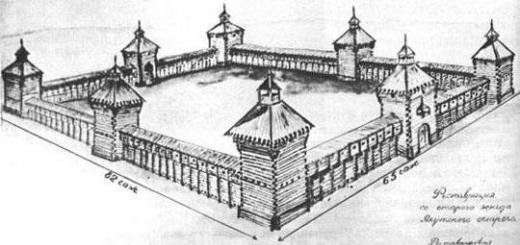It was in the 17th century that it became widespread. Enterprising traders, travelers, adventurers and Cossacks headed east. At this time, the oldest Russians were founded, some of them are now megacities.
Siberian fur trade
The first detachment of Cossacks appeared in Siberia during the reign of Ivan the Terrible. The army of the famous ataman Ermak fought with the Tatar Khanate in the Ob basin. It was then that Tobolsk was founded. At the turn of the 16th and 17th centuries. The Time of Troubles began in Russia. Due to the economic crisis, famine and military intervention of Poland, as well as peasant uprisings, the economic development of distant Siberia was suspended.
Only when the Romanov dynasty came to power and order was restored in the country did the active population again turn their gaze to the east, where vast spaces were empty. In the 17th century, the development of Siberia was carried out for the sake of furs. Fur was worth its weight in gold in European markets. Those who wanted to profit from trade organized hunting expeditions.
At the beginning of the 17th century, Russian colonization affected mainly the taiga and tundra regions. Firstly, it was there that the valuable furs were located. Secondly, the steppes and forest-steppes were too dangerous for settlers due to the threat of invasions by local nomads. Fragments of the Mongol Empire and Kazakh khanates continued to exist in this region, whose inhabitants considered the Russians their natural enemies.
Yenisei expeditions
On the northern route, the settlement of Siberia was more intense. At the end of the 16th century, the first expeditions reached the Yenisei. In 1607, the city of Turukhansk was built on its shore. For a long time it was the main transit point and springboard for the further advance of Russian colonists to the east.
Industrialists were looking for sable fur here. Over time, the number of wild animals has decreased significantly. This became an incentive to move on. The guiding arteries deep into Siberia were the Yenisei tributaries Nizhnyaya Tunguska and Podkamennaya Tunguska. At that time, cities were just winter huts where industrialists stopped to sell their goods or wait out the severe frosts. In spring and summer they left their sites and hunted for furs almost all year round.
Pyanda's journey
In 1623, the legendary traveler Pyanda reached the banks of the Lena. Almost nothing is known about the identity of this person. The little information about his expedition was passed on by word of mouth from industrialists. Their stories were recorded by historian Gerard Miller already in the era of Peter the Great. The exotic name of the traveler can be explained by the fact that he was a Pomor by nationality.
In 1632, on the site of one of his wintering quarters, the Cossacks founded a fort, which was soon renamed Yakutsk. The city became the center of the newly created voivodeship. The first Cossack garrisons faced hostile attitudes from the Yakuts, who even tried to besiege the settlement. In the 17th century, the development of Siberia and its farthest borders was controlled from this city, which became the northeastern border of the country.

Nature of colonization
It is important to note that colonization at that time was spontaneous and popular in nature. At first, the state practically did not interfere in this process. People went east on their own initiative, taking all risks upon themselves. As a rule, they were driven by the desire to make money from trading. Peasants who fled from their homes, escaping serfdom, also sought to the east. The desire to gain freedom pushed thousands of people into uncharted spaces, which made a huge contribution to the development of Siberia and the Far East. The 17th century gave peasants the opportunity to start a new life in a new land.
Villagers had to go to great lengths to start a farm in Siberia. The steppe was occupied by nomads, and the tundra turned out to be unsuitable for cultivation. Therefore, peasants had to create arable land in dense forests with their own hands, conquering plot after plot from nature. Only purposeful and energetic people could cope with such work. The authorities sent detachments of service people after the colonists. They did not so much discover lands as they were engaged in the development of already discovered ones, and were also responsible for security and tax collection. This is exactly how a fort was built in the southern direction, on the banks of the Yenisei, to protect civilians, which later became the rich city of Krasnoyarsk. This happened in 1628.

Dezhnev's activities
The history of the development of Siberia has captured on its pages the names of many brave travelers who spent years of their lives on risky ventures. One of these pioneers was Semyon Dezhnev. This Cossack ataman was originally from Veliky Ustyug, and went east to engage in fur mining and trade. He was a skilled navigator and spent most of his active life in northeastern Siberia.
In 1638, Dezhnev moved to Yakutsk. His closest ally was Pyotr Beketov, who founded cities such as Chita and Nerchinsk. Semyon Dezhnev was busy collecting yasak from the indigenous peoples of Yakutia. This was a special type of tax imposed by the state on the natives. Payments were often violated, as local princelings periodically rebelled, not wanting to recognize Russian power. It was for such a case that detachments of Cossacks were needed.

Ships in the Arctic seas
Dezhnev was one of the first travelers to visit the banks of rivers flowing into the Arctic seas. We are talking about such arteries as Yana, Indigirka, Alazeya, Anadyr, etc.
Russian colonists penetrated the basins of these rivers in the following way. First, the ships descended the Lena. Having reached the sea, the ships sailed east along the continental coasts. So they ended up at the mouths of other rivers, rising along which, the Cossacks found themselves in the most uninhabited and outlandish places of Siberia.
Discovery of Chukotka
Dezhnev's main achievements were his expeditions to Kolyma and Chukotka. In 1648, he went to the North to find places where valuable walrus ivory could be obtained. His expedition was the first to reach Here Eurasia ended and America began. The strait that separated Alaska from Chukotka was not known to the colonialists. Already 80 years after Dezhnev, Bering’s scientific expedition, organized by Peter I, visited here.
The journey of the desperate Cossacks lasted 16 years. It took another 4 years to return to Moscow. There Semyon Dezhnev received all the money due to him from the Tsar himself. But the importance of his geographical discovery became clear after the death of the brave traveler.

Khabarov on the banks of the Amur
If Dezhnev conquered new frontiers in the northeast direction, then the south had its own hero. It was Erofey Khabarov. This discoverer became famous after he discovered salt mines on the banks of the Kuta River in 1639. was not only an outstanding traveler, but also a good organizer. A former peasant founded a salt production plant in the modern Irkutsk region.
In 1649, the Yakut governor made Khabarov the commander of a Cossack detachment sent to Dauria. It was a remote and poorly explored region on the borders of the Chinese Empire. Natives lived in Dauria who were unable to provide serious resistance to Russian expansion. Local princelings voluntarily became subjects of the tsar after Erofey Khabarov’s detachment appeared on their lands.
However, the Cossacks had to turn back when the Manchus came into conflict with them. They lived on the banks of the Amur. Khabarov made several attempts to gain a foothold in this region through the construction of fortified forts. Due to confusion in the documents of that era, it is still unclear when and where the famous pioneer died. But, despite this, the memory of him was alive among the people, and much later, in the 19th century, one of the Russian cities founded on the Amur was named Khabarovsk.

Disputes with China
The South Siberian tribes, who became Russian subjects, did this to escape the expansion of the wild Mongol hordes, who lived only by war and the ruin of their neighbors. The Duchers and Daurs suffered especially. In the second half of the 17th century, the foreign policy situation in the region became even more complicated after the restless Manchus captured China.
The emperors of the new Qing dynasty began campaigns of conquest against the peoples living nearby. The Russian government tried to avoid conflicts with China, because of which the development of Siberia could suffer. In short, diplomatic uncertainty in the Far East persisted throughout the 17th century. Only in the next century did states enter into a treaty that formally defined the borders of the countries.

Vladimir Atlasov
In the middle of the 17th century, Russian colonists learned about the existence of Kamchatka. This territory of Siberia was shrouded in secrets and rumors, which only multiplied over time due to the fact that this region remained inaccessible to even the most daring and enterprising Cossack troops.
The explorer Vladimir Atlasov became the “Kamchatka Ermak” (as Pushkin put it). In his youth he was a yasak collector. Government service came easily to him, and in 1695, a Yakut Cossack became a clerk in the distant Anadyr prison.

His dream was Kamchatka... Having found out about it, Atlasov began preparing an expedition to the distant peninsula. Without this enterprise, the development of Siberia would be incomplete. A year of preparation and collection of necessary things was not in vain, and in 1697 Atlasov’s prepared detachment set off.
Exploring Kamchatka
The Cossacks crossed the Koryak Mountains and, reaching Kamchatka, split into two parts. One detachment went along the western coast, the other explored the eastern coast. Having reached the southern tip of the peninsula, Atlasov saw from afar islands previously unknown to Russian researchers. This was the Kuril Archipelago. There, in captivity among the Kamchadals, a Japanese named Denbey was discovered. was shipwrecked and fell into the hands of the natives. The liberated Denbey went to Moscow and even met with Peter I. He became the first Japanese the Russians had ever met. His stories about his native country were popular objects of conversation and gossip in the capital.
Atlasov, having returned to Yakutsk, prepared the first written description of Kamchatka in Russian. These materials were called “fairy tales”. They were accompanied by maps compiled during the expedition. For a successful campaign in Moscow he was awarded an incentive of one hundred rubles. Atlasov also became a Cossack head. A few years later he returned to Kamchatka again. The famous pioneer died in 1711 during a Cossack revolt.

Thanks to such people, in the 17th century the development of Siberia became a profitable and useful enterprise for the entire country. It was in this century that the distant region was finally annexed to Russia.
It went at a very fast pace. The advance of the Russians into Siberia went in an eastern direction, to the taiga, which was sparsely populated and richest in fur-bearing animals, since fur remained one of the main incentives for the development of Siberia at an early stage. Cossacks, Pomors and Moscow service people advanced from to in 15-20 years, founding first Tyumen and Tobolsk, and then Berezov, Tara, Narym, Surgut, Tomsk. In the first half of the 17th century. was passed just as quickly - mainly along rivers - after which Yeniseisk, Krasnoyarsk, Ilimsky, Bratsky, Yakutsky, Irkutsk forts, as well as New Mangazeya - Turukhansk appeared on the map. In the 30-40s of the 17th century, Russian explorers led by Ivan Moskvitin reached the shores. Semyon Dezhnev and Fedot Popov discovered the strait between and. During the course of the Russians, a connection was established with the peoples who inhabited the lands beyond and. The peoples of Siberia became acquainted with Russian culture. In the southern regions, more favorable for agriculture, Russian settlers began the agricultural development of the territory. By the middle of the 17th century, it transformed from the Russian state into the Russian state, as it included territories inhabited by different peoples. The area of Russia at the end of the 17th century was more than 14 million square meters. km.
D. Penda
Spontaneous popular colonization of Siberia was ahead of government colonization. “Free industrialists” walked ahead, and only in their footsteps were detachments of servicemen sent, bringing the local population under the “high sovereign hand” and taxing them with yasak - quitrent. In 1620, the “walking man” Penda set off from Turukhansk in search of the great one, at the head of 40 of the same free industrialists. This legendary journey lasted several years. Its participants covered about 10 thousand km. Penda's detachment climbed the Lower Tunguska, overcame rocks and rapids, reached its upper reaches and, dragging ships, reached the Lena, descending to the place where Yakutsk was later founded. From here the people of Penda reached the sources of the Lena and went through the steppes to. The first of the Russians to overcome its formidable rapids, Penda and his comrades returned to Turukhansk along an already familiar road.
Vasily Bugor
At the end of the 20s, a path was opened from the Angara along its tributary Ilim, and from Ilim by the Lena portage to the tributary of the Lena - Kuta. The Cossack Vasily Bugor passed this road, which soon became the main one, in 1628.
Ivan Rebrov
Particularly significant events were marked by campaigns in the northeast direction. In 1633, detachments of explorers led by Ivan Rebrov and Ilya Perfilyev went along the Lena River and reached the mouth of the Indigirka River. This was the beginning of Russian polar shipping.
Ivan Moskvitin
In 1639, a detachment of Tomsk Cossacks led by Ivan Moskvitin crossed the rivers from the Lena basin and sailed to the mouth of the Amur. The people of Moskvitin’s detachment examined the coast from the mouth of the Uda in the south to the modern one in the north; the mouths of many rivers, including the Okhota, were discovered.
Mikhail Stadukhin
The detachments of Mikhail Stadukhin and Dmitry Zyryan descended along the Indigirka to the Arctic Ocean, walked to the mouth of the Kolyma, where three winter quarters were set up. And through the upper reaches of Anadyr they proceeded south to the Sea of Okhotsk. In the 40s of the 17th century. The first drawing maps of Siberia appeared.
Vasily Poyarkov
Simultaneously with the advance to the north, there was also movement into the “Daurian land” - the Amur region. Participants in Vasily Poyarkov's military expedition went out to the area, explored the lower Amur region, and collected valuable information about the nature of this region. In honor of Vasily Poyarkov, a settlement on the Amur is named Poyarkovo.
Semyon Dezhnev and Fedot Popov
The expedition and Fedota Popova sailed on Kochs from the mouth of the Kolyma to the mouth of the Anadyr, opening the strait separating Asia and North Asia. Fedot Popov, who was the organizer of this campaign, soon died. Semyon Dezhnev went alone to report on the great discovery of world significance. The land route from Yakutsk to Moscow took more than two years. Semyon Dezhnev left Yakutsk for the capital at the end of July 1662, and arrived in Moscow only in September 1664.
Erofey Khabarov
In 1649, the wealthy businessman Erofei Khabarov, a fellow countryman of Semyon Dezhnev (both of them from Veliky Ustyug), equipped a large detachment of “hunting people” with his own funds and, leading it, moved to the Amur. The detachment walked along Olekma and through the Tugirsky portage to Shilka, marking the beginning of widespread development. Within a few years, the first groups of settlers appeared here, and at the confluence of the Nercha and the Shilka, the Nerchinsky fort was founded - another base for the further development of the Amur region.
Vladimir Atlasov
Atlasov's campaign ended the century of Russian great geographical discoveries. “Kamchatka Ermak,” as he was called, Vladimir Atlasov reached “the edge and end of the Siberian land” and marked the beginning of a new stage of geographical discoveries related to the study of Alaska.
Back in the middle of the 16th century, after the annexation of the Kazan Khanate, Russia’s eastern neighbor, the Siberian Khanate, entered into vassal dependence on the Russian sovereign for support in the fight against the Central Asian rulers. Russian merchants organized expeditions to acquire the main wealth of Siberia - furs - and had the right to build fortresses on the Irtysh and in the lands along the Tobol. In the 70s, the Siberian khans organized attacks on Russian possessions, set up small nomadic feudal lords against Russia, and prevented Russian merchants from entering Siberia. In 1581, the Stroganov merchants managed to organize a campaign by Ermak’s Cossack squad against the troops of Khan Kuchum. The capital was taken and after stubborn battles the Khanate was annexed to Russia - the first fortresses of Tyumen and Tobolsk were built, which became outposts for the penetration of Russian people into Siberia.
In the 17th century, Siberia was gradually developed by groups of Russian explorers. The government and merchants organized expeditions to explore the possibilities of fur trade and ore deposits. In 1648, Semyon Dezhnev’s detachment reached the shores of the Arctic Ocean and opened the strait between Asia and America, and at the turn of the 40-50s. Erofei Khabarov's detachment from Yakutsk reached the Amur and drew up a drawing of the Amur region - thus developing Eastern Siberia and the Far East. The government, interested in developing the rich region, organized peasant resettlement to Siberia from Russian regions on preferential terms, provided support to “walking people” in establishing a farm in Siberia, and built small towns. Some of the fugitive peasants rushed to Siberian industries. By the end of the 17th century, 150 thousand Russian families lived from the Urals to the Pacific Ocean, most of them farmers who plowed “tithe arable land” for the benefit of the state, that is, they became state peasants. The indigenous peoples of Siberia and the Far East adopted some new tools from the Russians and arable farming in the southern regions, but basically continued to pay the tax in kind - yasak, furs. By the end of the 17th century, income from the sale of furs accounted for a quarter of the income of the Russian state.
In the Amur region, the interests of Russia collided with the interests of China, where the Qing dynasty ruled. The main military operations took place over the fortress town of Albazin, which was destroyed by Chinese troops, and the Russians restored and defended for a year. According to the Nerchinsk Peace Treaty of 1689 with China, Russian troops secured part of the occupied lands, but liberated the lands in the upper reaches of the Amur. The Albazin fortress was razed.
Development of Siberia (briefly)
Development of Siberia (short story)
After Ermak’s successful campaigns, the further development of Siberia began to gain momentum. The Russians advanced in the eastern direction of Siberia, into the tundra and taiga sparsely populated areas rich in fur-bearing animals. After all, it was fur that was one of the most important incentives for the development of this region at that time.
In twenty years, Moscow service people, Pomors and Cossacks were able to make their way from the Ob and Irtysh to the Yenisei, building there first Tobolsk and Tyumen, and then Tomsk, Surgut, Narym, Tara and Berezov. In the first half of the seventeenth century, Krasnoyarsk, Yeniseisk and other cities appeared.
In the thirties and forties, explorers led by I. Moskvitin were able to reach the shores of the Sea of Okhotsk. Fedot Popov and Semyon Dezhnev discovered the strait between America and Asia. During the development of Siberia by the Russians, many geographical discoveries were made, and contacts were established with the peoples who for a long time inhabited the closed territories of the Far East and the Urals. At the same time, development went in both directions. Distant peoples could become acquainted with Russian culture.
In the southern regions of Siberia, which are more favorable for agriculture, Russian settlers laid the foundation for agricultural development of the land. So, by the middle of the seventeenth century, Russia was turning into a Russian state, but not a Russian one, since from now on the country included territories that were inhabited by various peoples.
At the same time, the spontaneous colonization of Siberia by the inhabitants of Russia often preceded the government colonization. Sometimes “free industrialists” walked ahead of everyone, and only after some time did detachments of servicemen follow in their footsteps, bringing local residents under the sovereign’s hand. In addition, service people taxed local residents with quitrent or yasak.
From 1615 to 1763, a special Siberian order functioned in Russia, which was responsible for managing new land territories. Later, Siberia was actually governed by governors-general, who were not even obliged to live there, transferring their governing privileges to commissioners.
At the beginning of the nineteenth century, N. Bestuzhev argued that Siberia was not a colony, but a colonial country developed by the peoples of Russia. But the Decembrist Batenkov, speaking about Siberia, emphasized the term colony, noting the exploitation of natural resources and poor population.
discoverer Siberia Manchu tribe
The economic situation of Russia in the 70-80s. The 17th century was difficult. The Livonian War and the invasion of the hordes of the Crimean Khanate, the oprichnina, the breakdown of large patrimonies and the growth of local land ownership, as well as natural disasters such as famine and pestilence, led to the massive ruin of peasants and townspeople. Significant areas were desolate, especially the central districts and the Novgorod-Pskov land. Crafts and trade fell into decline.
Strengthening feudal exploitation of the peasant masses in the 80-90s. The 16th century caused an aggravation of class contradictions. The internal political situation was further complicated by the famine of 1601-1603. and the peasant war.
Since 1611, an active struggle of the Russian people began to liberate the country from the Polish-Swedish invaders. According to the Stolbovo Peace Treaty of 1617, Sweden returned Novgorod and the Novgorod region to Russia, but at the same time retained the Izhora land with the shores of the Neva and the Gulf of Finland - Russia’s only access to the Baltic Sea. This was one of the most severe consequences of the intervention. In 1618, the Truce of Deulino was concluded with Poland. Only in the 20s of the 17th century did the gradual restoration of the country's agriculture, devastated by devastating wars, begin. The outskirts of the state were settled: counties south of the Oka River, the Middle Volga region, the Urals and Western Siberia. From the 20s to the early 40s of the 17th century, the growth of productive forces in cities occurred much more intensively than in the countryside, their population increased by about 60%. In the middle of the 17th century there were 226 cities in Russia. There has been a transition from a subsistence economy to a commodity-money economy. The craft, previously associated only with the execution of orders, began to focus on the market, and the first manufactories appeared. The all-Russian market began to take shape.
According to V.I. Lenin, approximately from the 17th century the country entered a new period of history, which is characterized by the actual merging of all such regions, lands and principalities into one whole. This merger was caused by increasing exchange between regions, gradually growing commodity circulation, and the concentration of small local markets into one all-Russian market. Since the leaders and masters of this process were capitalist merchants, the creation of these national ties was nothing more than the creation of bourgeois ties.
The isolation of the ruling class from the rest of the population intensified, and stratification began within the townspeople and peasant communities. The estate-representative monarchy acquired features of absolutism. In various areas of culture, the desire to free oneself from medieval church and religious dogmas was increasingly felt. The 17th century saw an unprecedented aggravation of the anti-feudal struggle: uprisings broke out and a peasant war broke out under the leadership of S. Razin. In the XVI-XVII centuries there was a significant expansion of the territory of the Russian state. Western Siberia up to the Ob River was included in Russia, and the movement of explorers to Siberia and the Far East intensified. Three stages can be distinguished in the Russian exploration of the Far East. The first stage occurs in the 16th century - this is the time of transition from developed to late feudalism, the formation of a powerful multinational Russian state, the strengthening of central power, and the enslavement of peasants. The first steps to develop the Trans-Ural lands were taken by the industrialists the Stroganov brothers. After Ermak’s defeat of the Siberian Khanate, vast expanses opened up before the explorers. Thus, the necessary conditions arose for the discovery of the Far East. At stage II, which lasted from the beginning to the middle of the 17th century, the Far East was discovered by the Russians, who moved from the Ob to the Yenisei, from the Yenisei to the Lena and further to the Pacific Ocean. Along the route, industrial and military people set up fort towns, which played the role of strongholds for governing the region and collecting yasak from the population. The third stage - the second half of the 17th century, is characterized by the inclusion of Siberia and the Far East in the process of the formation of the all-Russian market. Cities and agricultural centers arose on new lands. The Amur region became the territory of the Russian state. The population of the region was forced to repel the invasion of the troops of the Manchu emperors, and then, under pressure from superior forces, leave its southern part, which turned into a neutral, undelimited territory. Then the development of the north of the Far East, Western Dauria and the island part of the Pacific Ocean began.
The movement of the Russian people to Siberia and the Far East was a natural historical process, determined by changes in the economic and political development of the country in the 17th century. The development of commodity-money relations played a decisive role in this process. Fur, which the new lands were rich in, not only served as a source of filling the deficit of the state treasury, but also contributed to the growth of income of merchants and industrial people. During the campaigns, the explorers were given the task of exploring new lands and bringing under the high sovereign's hand the yasak payment of peoples who had not paid yasak before, and establishing trade ties with them. All explorers and polar sailors had exchange goods. They searched for minerals, especially silver, salt, mica, and copper, which the young Russian state really needed. There was a process of development of the territory, which generally marked the spread of socio-economic relations that were new to Siberia and the Far East and the introduction of new types of economic activity.
Until the 16th century The Russian state was mainly supplied with especially valuable furs by the Pechora and Perm lands, but by the middle of the century they were noticeably “industrialized.” At the same time, the demand for expensive furs increased, especially abroad. Russian sable has long been highly valued in many European and Asian countries. From the middle of the 16th century. the possibilities for profitable sales of furs increased sharply, as direct trade links were established with Western Europe through the White Sea, and the inclusion of the entire Volga route into Russia made it possible to export Russian goods directly to the countries of the East. It is clear that under such conditions, Siberia, with its seemingly unimaginable fur riches, began to attract special attention. “Sable Places” began to attract industrialists and traders. But the strengthening state was also vitally interested in Siberian furs. With increasing power, expenses increased, and certain difficulties were associated with replenishing the treasury. And Siberia, with its natural and geographical conditions, opened up significant prospects for the Russian state Leontyev G.A. Explorer Erofey Pavlovich Khabarov. / G.A. Leontyev - M.: Education, 1991. - 110 p..
Another important prerequisite for the development of Siberia was the proximity to the eastern borders of Russia of India and China, trade with which promised huge income to the treasury. The movement to the east was also due to the strengthening of feudal oppression and the intensity of the class struggle in the European part of the country. Tsarism did not interfere with voluntary resettlement, since, firstly, it removed the restless element from the central regions, and secondly, the achievements of free colonization were used to spread tsarist power and strengthen feudalism.
The peoples of Siberia and the Far East in the first half of the 17th century were at the stage of decomposition of primitive communal relations, less often - at the stage of early feudal relations, did not have their own statehood and were often at enmity with each other. The level of development of production forces was low, appropriating forms of economy predominated. From the entry of these peoples into Russia, not only the peoples of Russia, but also the aborigines objectively benefited, since this contributed to the cessation of civil strife and the acceleration of socio-economic development. The annexation of the Far Eastern lands was predominantly peaceful, although military methods were also used. That is why it took Russian explorers and sailors only about 60 years to advance from the Urals to the shores of the Pacific Ocean.
Along with internal ones, there were also external reasons that contributed to Russia’s movement to the east. They consisted of the need to secure the Russian state from attacks by nomadic tribes from the east and southeast, to create a strong rear, and thereby ensure the possibility of breaking through the isolation and blockade in the west and southwest of the country. In addition, the government began to show special interest in the development of foreign trade, since furs and walrus teeth were in great demand on the world market.
Internal and external reasons together determined such features of the discovery and development of the territory of the Far East as the speed of this process, the folk, peasant nature of colonization, and the gradual formation of common interests of the Russian and indigenous populations. Russia in the 17th century was the world's largest nation-state. Having reached the shores of the Pacific Ocean, it became a neighbor of the Far Eastern powers: China, Japan, the USA and Korea.










